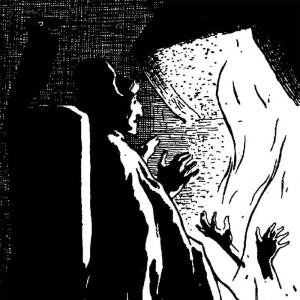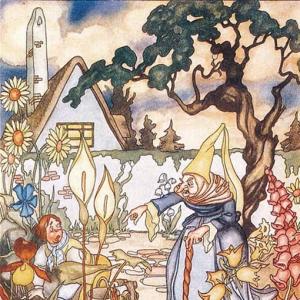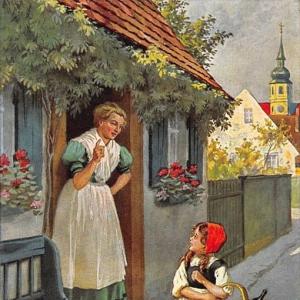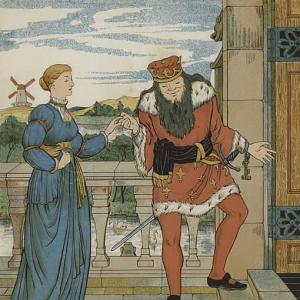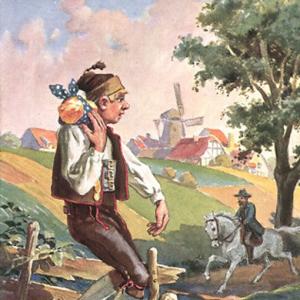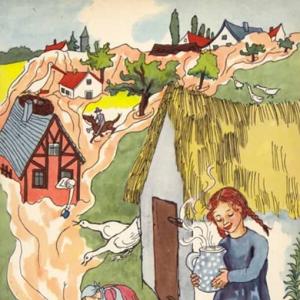Reading time: 6 min
On the highroad in the forest there stood a lonely farmhouse. The road passed right through its courtyard. All the windows were open to the warm sun; within the house there was bustling life, but out in the yard, under an arbor of blooming lilacs, there rested an open coffin. The dead man had been carried to it, and this morning he was to be buried. There was no one to stand by the coffin and look down in sorrow at the dead, no one to shed a tear over him.
A white cloth covered his face, and under his head lay a great thick book, its leaves formed of whole sheets of gray paper. And between each leaf there lay withered flowers, kept close and hidden, so that the book was really a complete herbarium, gathered in many different places. His request had been that the book be buried with him, for each flower had formed a chapter of his life.
„Who is the dead man?“ we asked; and the answer was: „The old student of Upsala. They say he was once a brilliant man who knew foreign languages and could sing and write songs, too. But it was also said that something went wrong with him, and he wasted his thoughts and himself in drinking. Finally, when his health was gone he came out here to the country, where some kindly person paid his board and lodging. He was as gentle as a child, but when his dark moods came on him he became as strong as a giant and ran about the forest like a hunted beast.
But if we could manage to get him home and persuade him to open the book with the withered flowers, he would sit quietly all day long, looking at one flower after another, and often the tears rolled down his cheeks. God only knows what thoughts those flowers brought back to him. But he begged that the book be laid in the coffin with him, so there it is. In a little while we’ll nail the lid down, and then he will have his sweet rest in the grave.“ We lifted up the cloth. There was a peaceful look on the face of the dead man; a ray of sunshine flickered across it. A swallow darted swiftly into the arbor and wheeled rapidly, twittering above the dead man’s head.
Surely we all know that strange feeling when we take out old letters of our youth and read them. All the hopes and sorrows of our life seem to rise up before us again. How many of those whom we then knew and were on intimate terms with are dead to us now! Yet they are still alive, although for a long time they have not been in our thoughts – those whom we once thought we should cling to forever, and share their joys and sorrows.
The faded oak leaf in that silent book is the memento of a friend, the school friend who was to remain a friend for life. He himself had fastened that leaf in the student’s cap in the green forest long ago, when that lifelong bond of friendship was made. Where is that friend now? The leaf is kept. The bond-broken. Here is a foreign hothouse plant, far too tender for the gardens of the North; its fresh odor seems to cling to it still. The daughter of a noble house gave it to him out of her own garden.
Here is a water lily that he himself plucked, and watered with his bitter tears, a water lily of sweet waters. And what do the leaves of this nettle tell us? What were his thoughts when he plucked it and laid it away? Here are lilies of the valley from the dark solitudes of the forest, honeysuckle from the taproom flowerpot, and here the sharp, bare grass blade. Gently the blooming lilac bends its fresh and fragrant clusters over the dead man’s head. The swallow darts by again – „Quivit! Quivit!“ Now the men come with nails and hammer. The lid is laid over the dead, who rests his head silently on the silent book. Hidden – forgotten!
 Learn languages. Double-tap on a word.Learn languages in context with Childstories.org and Deepl.com.
Learn languages. Double-tap on a word.Learn languages in context with Childstories.org and Deepl.com.Backgrounds
Interpretations
Summary
Linguistics
„The Silent Book“ is a lesser-known fairy tale by Danish author Hans Christian Andersen. Born in 1805, Andersen is best known for his timeless and imaginative stories that have been translated into more than 125 languages and continue to be popular among children and adults alike. His most famous works include „The Little Mermaid,“ „The Ugly Duckling,“ and „The Emperor’s New Clothes.“ Throughout his career, Andersen published more than 150 fairy tales and stories.
Hans Christian Andersen’s stories often contain moral lessons or messages and sometimes include autobiographical elements, as Andersen himself experienced poverty and hardship during his life. His stories are renowned for their depth, emotion, and symbolism, and they have been adapted into numerous films, plays, and ballets.
„The Silent Book“ is one such fairy tale that delves into themes such as memory, the passage of time, human connection, and the consequences of self-destructive choices. The story, as with many of Andersen’s other works, uses vivid imagery, symbolism, and emotion to provide a powerful narrative that resonates with readers. Though „The Silent Book“ may not be as well-known as some of Andersen’s other tales, it still showcases his ability to create evocative stories that explore the complexities of human life and emotion.
„The Silent Book“ by Hans Christian Andersen can be interpreted in various ways, as it explores themes such as memory, loss, friendship, and the passage of time. Here are some possible interpretations of the story.
The power of memory: The withered flowers in the silent book serve as tangible representations of the student’s memories, each carrying a unique story from his past. The tale highlights the emotional power of these memories and the solace they can provide, even in the darkest moments of one’s life.
The passage of time and the impermanence of life: The story emphasizes the passage of time and the transient nature of human existence. The withered flowers symbolize the fleeting nature of life, relationships, and emotions, showing that everything eventually fades and changes.
The importance of human connection: Throughout the story, the student’s relationships with others play a crucial role in his life. The friendships he once cherished, the bond with the noblewoman, and the care of his benefactor all demonstrate the importance of human connection. The fact that no one is present to mourn the student’s passing underscores the tragedy of losing such connections.
The consequences of choices and self-destruction: The old student’s life takes a downward turn due to his alcoholism, which causes him to lose his health and connections to others. His story serves as a cautionary tale of the consequences that come with self-destructive behavior.
The search for meaning and redemption: Despite his struggles, the student finds comfort and solace in his silent book. It suggests that there is always an opportunity for redemption, and that finding meaning in one’s life can come from reflecting on past experiences and memories.
The healing power of nature: The withered flowers in the silent book, as well as the blooming lilacs and the swallow, symbolize the healing power of nature. Nature plays a role in soothing the student’s soul and offering him solace in his final moments.
„The Silent Book“ is a touching fairy tale by Hans Christian Andersen that tells the story of a lonely old student who finds solace in his book of withered flowers. The tale begins in a secluded farmhouse, where the student’s open coffin rests under an arbor of blooming lilacs. There are no friends or family members present to mourn his passing, and the only item placed in the coffin is a thick book filled with withered flowers – a herbarium representing various chapters of his life.
The old student was known to have been intelligent, well-educated, and gifted in languages and music. However, he lost himself to alcoholism, which ultimately damaged his health and led him to live in the country, supported by the kindness of a benefactor. He was gentle at heart, but was often troubled by his dark moods. The book with the withered flowers served as a comfort to him. He would sit all day looking at the flowers and often be moved to tears, reflecting on the memories they carried.
As the story unfolds, each withered flower reveals a piece of the student’s past, recounting the friendships he once had, the noblewoman who gifted him a delicate plant, a water lily plucked and watered with his tears, and many more. Each flower and leaf represents a different emotion or phase of the student’s life. The peaceful expression on the dead man’s face is a testament to the solace he found in his silent book. As the story comes to a close, the lilac blooms bend over his head, and the swallow swiftly passes by. The men arrive to nail the coffin shut, and the student is laid to rest, his head upon the book, hidden and forgotten.
The fairy tale „The Silent Book“ by Hans Christian Andersen offers a poignant meditation on memory, loss, and the passage of time through its linguistic and thematic elements.
Imagery and Symbolism: Andersen employs vivid imagery to create a deeply emotional atmosphere. The open coffin under blooming lilacs juxtaposes life and death, hinting at the continuity of nature in the face of mortality. The lilacs, the swallow, and the sunlight lend a paradoxical beauty and tranquility to the scene of death. The silent book serves as a powerful symbol of the old student’s life, with each withered flower representing a chapter of his past. The flowers evoke memories—some joyful, others sorrowful—emphasizing the transient yet enduring nature of human experiences.
Use of Contrast: The narrative contrasts inner and outer worlds. The bustling life within the farmhouse versus the stillness of the coffin outside highlights the gap between the living and the dead. Similarly, the old student’s past brilliance and current obscurity underscore the tension between potential and realization, as well as the consequences of personal choices.
Personification and Emotional Resonance: The flowers in the book are given life-like qualities, as they evoke memories and emotions in the old student. This personification creates an emotional resonance, as readers can relate to the act of revisiting tangible reminders of the past, like letters or mementos. Such objects become vessels of memory and emotional catalysts that bridge past and present.
Repetition and Rhythm: Andersen’s use of repetition reinforces key themes. The repeated references to the „silent book“ highlight its significance as a repository of the student’s life and memories. Similarly, the narrative’s rhythmic cadence, marked by the recurrent imagery of the swallow and the lilacs, conveys a sense of inevitability and the cyclical nature of life and death.
Melancholic Tone: The story carries a melancholic tone, underscored by phrases like „no one to shed a tear,“ and „hidden – forgotten. “ This tone reflects the universal truth of human mortality and the often-isolated journey of life. The gentle yet somber language evokes empathy for the old student, encouraging readers to reflect on their own lives and relationships.
Metaphor and Allusion: Andersen uses metaphor to imbue the narrative with deeper meaning. The book itself is a metaphor for the student’s life story, with each flower-chapter representing a significant moment or relationship. The allusion to „old letters of our youth“ invites readers to draw on their personal experiences of nostalgia and introspection, enhancing the tale’s universal relatability.
Overall, „The Silent Book“ uses language strategically to explore themes of memory, identity, and the passage of time, creating a rich narrative that resonates on both an individual and collective level. Through its symbolic and emotive use of language, the tale encourages introspection and a deeper appreciation for the ephemeral yet meaningful nature of life.
Information for scientific analysis
Fairy tale statistics | Value |
|---|---|
| Translations | DE, EN, DA, ES |
| Readability Index by Björnsson | 28.4 |
| Flesch-Reading-Ease Index | 83.7 |
| Flesch–Kincaid Grade-Level | 5.7 |
| Gunning Fog Index | 7.9 |
| Coleman–Liau Index | 8.1 |
| SMOG Index | 7.5 |
| Automated Readability Index | 6.1 |
| Character Count | 3.671 |
| Letter Count | 2.852 |
| Sentence Count | 42 |
| Word Count | 701 |
| Average Words per Sentence | 16,69 |
| Words with more than 6 letters | 82 |
| Percentage of long words | 11.7% |
| Number of Syllables | 880 |
| Average Syllables per Word | 1,26 |
| Words with three Syllables | 23 |
| Percentage Words with three Syllables | 3.3% |

 Facebook
Facebook  Whatsapp
Whatsapp  Messenger
Messenger  Telegram
Telegram Reddit
Reddit

